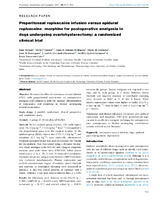Mostrar el registro sencillo del ítem
Preperitoneal ropivacaine infusion versus epidural ropivacaine–morphine for postoperative analgesia in dogs undergoing ovariohysterectomy: a randomized clinical trial
| dc.contributor.author | Morgaza, Juan | |
| dc.contributor.author | Latorre, David F. | |
| dc.contributor.author | Serrano-Rodríguez, Juan Manuel | |
| dc.contributor.author | Granadosa, María M. | |
| dc.contributor.author | Domínguez, Juan M. | |
| dc.contributor.author | Fernández Sarmiento, José Andrés | |
| dc.contributor.author | Quirós Carmona, Setefilla | |
| dc.contributor.author | Navarrete Calvo, Rocío | |
| dc.date.accessioned | 2021-11-10T13:15:58Z | |
| dc.date.available | 2021-11-10T13:15:58Z | |
| dc.date.issued | 2021 | |
| dc.identifier.uri | http://hdl.handle.net/10396/22077 | |
| dc.description.abstract | Objective To assess the effect of continuous wound infusion (CWI) with preperitoneal ropivacaine on postoperative analgesia and compare it with the epidural administration of ropivacaine and morphine in bitches undergoing ovariohysterectomy. Study design A parallel, randomized, clinical, prospective and nonblinded study. Animals A group of 38 Greyhound bitches. Methods In the catheter group (CathG), CWI with ropivacaine 1% (1 mg kg–1 + 0.8 mg kg–1 hour–1) was applied to the preperitoneal space over the surgical incision. In the epidural group (EpiG), ropivacaine 0.5% (1.3 mg kg–1) and morphine (0.1 mg kg–1) were epidurally administered. Occipital-coccygeal length was used to calculate the volume for the epidural. Pain was scored using a dynamic interactive visual analogue scale (DIVAS) and Glasgow composite measure pain scale–short form (CMPS-SF) before anaesthesia and at 2, 4, 6, 18, 21 and 24 hours after extubation. Incisional sensitivity using a dynamometer (MWTs-incision) was evaluated simultaneously. Plasma ropivacaine and cortisol concentrations, degree of sedation, motor blockade and response to interdigital clamping were measured or assessed. A two-way mixed analysis of variance and a Mann–Whitney U test were used to analyse data; p < 0.05. Results No differences were detected in the DIVAS (p = 0.301), CMPS-SF (p = 0.600) scores, MWTs-incision measurements (p = 0.257) and cortisol values (p = 0.878) between the groups. Rescue analgesia was required in two dogs, one in each group, at 2 hours. Sedation, motor blockade and negative response to interdigital clamping were detected in EpiG at 2, 4 and 6 hours. Mean plasma ropivacaine values were higher in CathG (0.475 ± 0.164 ng mL–1) than in EpiG (0.184 ± 0.213 ng mL–1; p = 0.001). Conclusion and clinical relevance Compared with epidural ropivacaine and morphine, CWI with preperitoneal ropivacaine is an effective analgesic technique for postoperative pain management in bitches undergoing ovariohysterectomy without motor blockade. | es_ES |
| dc.format.mimetype | application/pdf | es_ES |
| dc.language.iso | eng | es_ES |
| dc.publisher | MDPI | es_ES |
| dc.rights | https://creativecommons.org/licenses/by/4.0/ | es_ES |
| dc.source | Veterinary Anaesthesia and Analgesia 48, 935-942 (2021) | es_ES |
| dc.subject | Continuous wound infusion | es_ES |
| dc.subject | Dogs | es_ES |
| dc.subject | Epidural | es_ES |
| dc.subject | Pain management | es_ES |
| dc.subject | Ropivacaine | es_ES |
| dc.title | Preperitoneal ropivacaine infusion versus epidural ropivacaine–morphine for postoperative analgesia in dogs undergoing ovariohysterectomy: a randomized clinical trial | es_ES |
| dc.type | info:eu-repo/semantics/article | es_ES |
| dc.relation.publisherversion | https://doi.org/10.1016/j.vaa.2021.04.009 | es_ES |
| dc.rights.accessRights | info:eu-repo/semantics/openAccess | es_ES |

